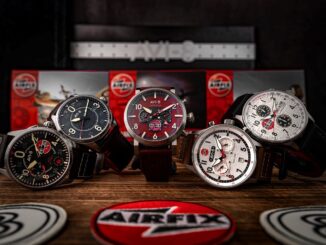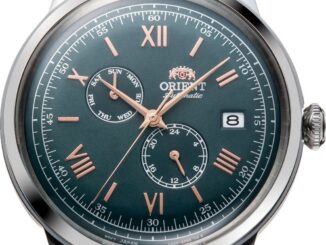It’s debatable whether or not the Omega Speedmaster is the world’s most famous watch, but it is indisputably the most travelled. However, before we get on to its relationship with space exploration, let’s look at the watch itself.
First manufactured in 1958 by Omega Watch company in Biene, Switzerland, it is a chronograph capable of measuring elapsed time in seconds, minutes and hours. It has a co-axial escapement mechanism and is manually wound with a power reserve in excess of 48 hours.
The highly legible 42mm black face with luminous markers is housed in a stainless steel waterproof case; it is anti-magnetic and shock protected and there is a tachymeter outer scale used for calculating speeds. Purchasers can choose between the original hesalite glass, with an embossed case back, or sapphire-crystal glass on both sides.
There are three sub-dials. The left-hand one is the second hand and runs continuously; the right hand dial records minutes and the lower central dial records hours. The sweep second hand is used in conjunction with the second and third dials when the stop-watch function is used, thereby not interfering with the normal time display. Expect to pay around £5,700 dependent on the version you choose.
The Speedmaster however, is more than just a great watch, it is woven into the history of space travel. In 1962, NASA began the search for a wristwatch that could be worn by the Gemini and Apollo astronauts so they could time space walks and other ‘extra-vehicular activity’. They purchased a number of watches from a variety of manufacturers and subjected them to a series of tests that included violent acceleration, vibration and extreme changes in temperature.
Only one watch, the Omega Speedmaster Professional, purchased over the counter from a jewellery shop in Houston, survived all the tests. In 1965, with the launch of the first Gemini flight, the watch became part of the astronauts’ standard equipment. Using a velcro strap to attach it to the outside of his space suit, it was worn by astronaut Edward White on the first ever space walk. Later, many astronauts wore two watches, one on their space suite and another on their wrist. One watch was set on Mission Elapsed time (MET) and the other was set on Greenwich Mean Time (GMT) or Houston time.
On the historic Apollo 11 flight the watch timed the two hours and forty minutes that Buzz Aldrin and Neil Armstrong spent on the surface of the moon. It is believed that due to a failure in the Lunar Module, Neil Armstrong left his watch behind as a back-up so it was Buzz Aldrin’s watch that made it to the lunar surface.
Disaster struck in 1970 on the Apollo 13 mission, which was also scheduled for a moon landing. Two days into the mission an explosion left the Command Module without electrical power and the crew of three were forced to transfer to the lunar module and start up its support and navigation systems. The lunar module was supposed to support two people for two days but there were three astronauts and they were four days from home. The astronauts had to shut down all electrical equipment except for the radio, which was on receive-only. As they rounded the moon and headed for home, James Lovell, the mission commander, used his watch to time the rocket thrusts required to get them home safely.
As the pressure increased on NASA to use American equipment, in August 1972 NASA invited companies to submit products for testing. In order to comply with the ‘Buy America’ rules, Omega had the watch cases made in Michigan and the glass was installed there before being sent to Switzerland where the movements were added. After exhaustive tests, once again the Omega product proved faultless.
The Russians also selected the Omega watch to be supplied to all cosmonauts. In 1975, when American astronauts met their Russian counterparts in space, their historic handshakes were marked by the fact that all crew members were wearing the same watches.
Despite the advances in technology and improvements in reliability, the Speedmaster Professional is still the only watch that’s engraved on the reverse “Flight Qualified by NASA for all Manned Space Missions”.
I know, I wear mine every day.
For more information on the Omega Speedmaster Moonwatch Professional, please visit: www.omegawatches.com.
Author Bio:
Mike Pickup is an award-winning travel writer and photographer who has over one hundred features a year published in newspapers, magazines and travel trade titles.
Photographs by Mike Pickup





Be the first to comment